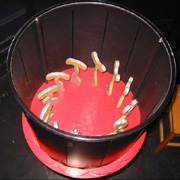


|
Perception
|
Zoetrope
|
The
ZOETROPE was invented in the mid-1800’s, long before the development
of the movie camera and animated cartoons, as a way of deriving
motion from still pictures. Visitors are invited to look through
the slits at the drawings and turn the crank at the side of the
exhibit as fast as they can. (Turning the crank the other way causes
the balls to appear to roll in the opposite direction.) As the cylinder
rotates, the user sees a fragment of the picture on the far side
of the cylinder. When the next slit passes the eye it reveals a
slightly different part of the picture. Each image lingers in the
viewer’s eye and brain long enough to merge with the next image.
This phenomenon, called persistence of vision, creates the illusion
of a continuously moving picture.
|

|







|